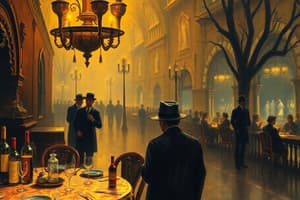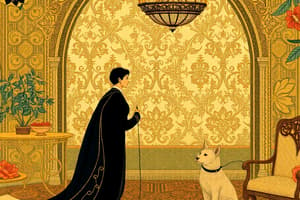Podcast
Questions and Answers
What was a significant issue faced by African Americans regarding employment by 1932?
What was a significant issue faced by African Americans regarding employment by 1932?
- African Americans were given preferential hiring practices.
- African Americans received equal pay for equal work.
- 50% of African Americans were unemployed. (correct)
- Unemployment rates were lower than white counterparts.
Which organization became involved in the Scottsboro case advocating for the defendants?
Which organization became involved in the Scottsboro case advocating for the defendants?
- The Southern Christian Leadership Conference
- The Urban League
- The Student Nonviolent Coordinating Committee
- The National Association for the Advancement of Colored People (correct)
What was a major outcome of the Supreme Court ruling in the Scottsboro case?
What was a major outcome of the Supreme Court ruling in the Scottsboro case?
- Death sentences were commuted to lengthy prison terms. (correct)
- The Supreme Court upheld the trials as fair.
- The death sentences were maintained.
- All defendants were acquitted and released.
How did the Scottsboro case contribute to future civil rights movements?
How did the Scottsboro case contribute to future civil rights movements?
What social issue escalated due to the volatile context of the early 1930s in America?
What social issue escalated due to the volatile context of the early 1930s in America?
What was one major outcome of the 19th Amendment regarding women's rights?
What was one major outcome of the 19th Amendment regarding women's rights?
Which aspect characterized the cultural shift in the post-WWI era for youth?
Which aspect characterized the cultural shift in the post-WWI era for youth?
What was a central theme of the Harlem Renaissance?
What was a central theme of the Harlem Renaissance?
What was a significant economic implication of the post-WWI period for women?
What was a significant economic implication of the post-WWI period for women?
Which movement was notably linked to the changing perceptions of African American identity during the 1920s?
Which movement was notably linked to the changing perceptions of African American identity during the 1920s?
Which law was passed in 1921 focusing on maternal and infant health?
Which law was passed in 1921 focusing on maternal and infant health?
What was a noted consequence of the Great Migration for African Americans in the North?
What was a noted consequence of the Great Migration for African Americans in the North?
What social change is associated with the emergence of the 'New Woman' in the 1920s?
What social change is associated with the emergence of the 'New Woman' in the 1920s?
What was the primary goal of the Negro Improvement Association founded by Marcus Garvey?
What was the primary goal of the Negro Improvement Association founded by Marcus Garvey?
Which of the following best describes the Lost Generation?
Which of the following best describes the Lost Generation?
What was a significant consequence of the 18th Amendment during Prohibition?
What was a significant consequence of the 18th Amendment during Prohibition?
Which political figure is associated with the idea of the 'New Negro'?
Which political figure is associated with the idea of the 'New Negro'?
Which statement accurately reflects the political landscape during the Republican Ascendancy in the 1920s?
Which statement accurately reflects the political landscape during the Republican Ascendancy in the 1920s?
What literary theme is commonly associated with the works of the Lost Generation authors?
What literary theme is commonly associated with the works of the Lost Generation authors?
Who was a prominent figure associated with Prohibition enforcement in Chicago known for extensive bootlegging?
Who was a prominent figure associated with Prohibition enforcement in Chicago known for extensive bootlegging?
How did W.E.B. Du Bois view white supremacy and its impact on black Americans?
How did W.E.B. Du Bois view white supremacy and its impact on black Americans?
Flashcards are hidden until you start studying
Study Notes
The 1920s: A Time of Change and Conflict
- The 1920s saw the rise of a new generation disillusioned by World War I, seeking a break from traditional norms, and embracing a more modern and liberated lifestyle.
- African Americans faced significant economic hardship and racial violence in the 1920s, with widespread unemployment, price gouging, and lynchings.
- The Scottsboro Boys case, involving nine young black men falsely accused of rape, highlighted the rampant racism and injustice within the American legal system.
- The 1920s witnessed the rise of the "New Woman," marked by greater female liberation, access to education and employment, and a rejection of Victorian ideals.
- The 19th Amendment, granting women the right to vote, empowered women politically, but systemic discrimination persisted in the workplace.
- The Harlem Renaissance, a cultural and artistic movement centered in Harlem, New York, celebrated African American identity, fostering a sense of pride and cultural expression.
- Key figures in the Harlem Renaissance included Langston Hughes, Zora Neale Hurston, and Claude McKay, who explored themes of racial identity, oppression, and the African American experience.
- W.E.B. Du Bois, a prominent scholar and activist, encouraged black pride, rejected white supremacy, and advocated for the advancement of African Americans.
- Marcus Garvey promoted the "Back to Africa" movement, advocating for black self-determination and a rejection of American society.
- The 18th Amendment, ratified in 1919, prohibited the manufacture, sale, and transportation of alcoholic beverages, leading to a surge in illegal alcohol production and bootlegging.
- Al Capone, a notorious gangster, built a criminal empire in Chicago through bootlegging, gambling, and other illicit activities.
- The 1920s witnessed a growing sense of disillusionment and pessimism among American intellectuals and artists, often referred to as the "Lost Generation."
- Authors like F. Scott Fitzgerald, Ernest Hemingway, and Sinclair Lewis explored themes of alienation, despair, and the perceived failings of American society.
- The Republican Party gained significant political power in the 1920s, marking a shift towards pro-business policies, a return to traditional values, and a response to the perceived threat of radicalism.
- The era saw the emergence of Warren G. Harding, a Republican president associated with the "Return to Normalcy" after World War I.
Studying That Suits You
Use AI to generate personalized quizzes and flashcards to suit your learning preferences.




